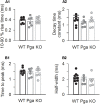Disruption of Otoferlin Alters the Mode of Exocytosis at the Mouse Inner Hair Cell Ribbon Synapse
- PMID: 30687007
- PMCID: PMC6338019
- DOI: 10.3389/fnmol.2018.00492
Disruption of Otoferlin Alters the Mode of Exocytosis at the Mouse Inner Hair Cell Ribbon Synapse
Abstract
Sound encoding relies on Ca2+-mediated exocytosis at the ribbon synapse between cochlear inner hair cells (IHCs) and type I spiral ganglion neurons (SGNs). Otoferlin, a multi-C2 domain protein, is proposed to regulate Ca2+-triggered exocytosis at this synapse, but the precise mechanisms of otoferlin function remain to be elucidated. Here, performing whole-cell voltage-clamp recordings of excitatory postsynaptic currents (EPSCs) from SGNs in otoferlin mutant mice, we investigated the impact of Otof disruption at individual synapses with single release event resolution. Otof deletion decreased the spontaneous release rate and abolished the stimulus-secretion coupling. This was evident from failure of potassium-induced IHC depolarization to stimulate release and supports the proposed role of otoferlin in Ca2+ sensing for fusion. A missense mutation in the Otof gene (pachanga), in which otoferlin level at the IHC plasma membrane was lowered without changing its Ca2+ binding, also reduced the spontaneous release rate but spared the stimulus-secretion coupling. The slowed stimulated release rate supports the hypothesis that a sufficient abundance of otoferlin at the plasma membrane is crucial for the vesicle supply. Large-sized monophasic EPSCs remained present upon Otof deletion despite the drastic reduction of the rate of exocytosis. However, EPSC amplitude, on average, was modestly decreased. Moreover, a reduced contribution of multiphasic EPSC was observed in both Otof mutants. We argue that the presence of large monophasic EPSCs despite the exocytic defect upon Otof deletion supports the uniquantal hypothesis of transmitter release at the IHC ribbon synapse. Based upon the reduced contribution of multiphasic EPSC, we propose a role of otoferlin in regulating the mode of exocytosis in IHCs.
Keywords: EPSC; auditory; calcium; cochlea; hair cell; otoferlin; ribbon synapse; spiral ganglion neuron.
Figures





Similar articles
-
Viral Transfer of Mini-Otoferlins Partially Restores the Fast Component of Exocytosis and Uncovers Ultrafast Endocytosis in Auditory Hair Cells of Otoferlin Knock-Out Mice.J Neurosci. 2019 May 1;39(18):3394-3411. doi: 10.1523/JNEUROSCI.1550-18.2018. Epub 2019 Mar 4. J Neurosci. 2019. PMID: 30833506 Free PMC article.
-
The upregulation of K+ and HCN channels in developing spiral ganglion neurons is mediated by cochlear inner hair cells.J Physiol. 2024 Oct;602(20):5329-5351. doi: 10.1113/JP286134. Epub 2024 Sep 26. J Physiol. 2024. PMID: 39324853
-
Otoferlin, defective in a human deafness form, is essential for exocytosis at the auditory ribbon synapse.Cell. 2006 Oct 20;127(2):277-89. doi: 10.1016/j.cell.2006.08.040. Cell. 2006. PMID: 17055430
-
New insights into cochlear sound encoding.F1000Res. 2016 Aug 26;5:F1000 Faculty Rev-2081. doi: 10.12688/f1000research.8924.1. eCollection 2016. F1000Res. 2016. PMID: 27635230 Free PMC article. Review.
-
Otoferlin as a multirole Ca2+ signaling protein: from inner ear synapses to cancer pathways.Front Cell Neurosci. 2023 Jul 19;17:1197611. doi: 10.3389/fncel.2023.1197611. eCollection 2023. Front Cell Neurosci. 2023. PMID: 37538852 Free PMC article. Review.
Cited by
-
Candidate Key Proteins in Tinnitus: A Bioinformatic Study of Synaptic Transmission in Spiral Ganglion Neurons.Cell Mol Neurobiol. 2023 Nov;43(8):4189-4207. doi: 10.1007/s10571-023-01405-w. Epub 2023 Sep 22. Cell Mol Neurobiol. 2023. PMID: 37736859 Free PMC article.
-
Impaired Hearing and Altered Subplate Circuits During the First and Second Postnatal Weeks of Otoferlin-Deficient Mice.Cereb Cortex. 2022 Jun 16;32(13):2816-2830. doi: 10.1093/cercor/bhab383. Cereb Cortex. 2022. PMID: 34849612 Free PMC article.
-
Functions of Vertebrate Ferlins.Cells. 2020 Feb 25;9(3):534. doi: 10.3390/cells9030534. Cells. 2020. PMID: 32106631 Free PMC article. Review.
-
Otoferlin Is Required for Proper Synapse Maturation and for Maintenance of Inner and Outer Hair Cells in Mouse Models for DFNB9.Front Cell Neurosci. 2021 Jul 14;15:677543. doi: 10.3389/fncel.2021.677543. eCollection 2021. Front Cell Neurosci. 2021. PMID: 34335185 Free PMC article.
-
Congenital Deafness and Recent Advances Towards Restoring Hearing Loss.Curr Protoc. 2021 Mar;1(3):e76. doi: 10.1002/cpz1.76. Curr Protoc. 2021. PMID: 33780161 Free PMC article.
References
LinkOut - more resources
Full Text Sources
Molecular Biology Databases
Miscellaneous

